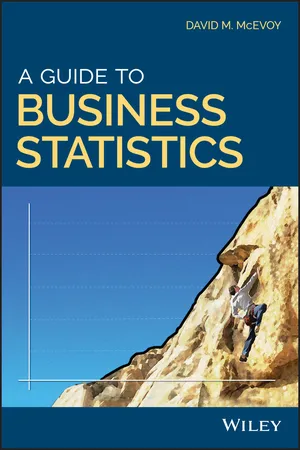Technology & Engineering
Large Sample Confidence Interval
A large sample confidence interval is a statistical measure used to estimate the true value of a population parameter, such as a mean or proportion, based on a large sample of data. It provides a range of values within which the true parameter is likely to fall, along with a level of confidence associated with the estimate.
Written by Perlego with AI-assistance
Related key terms
Related key terms
1 of 4
Related key terms
1 of 3
7 Key excerpts on "Large Sample Confidence Interval"
- eBook - ePub
- Alandra Kahl(Author)
- 2008(Publication Date)
- Bentham Science Publishers(Publisher)
Estimation Alandra Kahl1 Department of Environmental Engineering, Penn State Greater Allegheny, PA 15132, USAAbstract
It is critically important for researchers to select the correct sample size to determine the population means. By understanding the difference between small and large sample sets, researchers can then construct intervals of confidence that assist in determining the population means. Confidence intervals are the margins of the error present within the dataset and are included to show the confidence of the researcher in the integrity of their dataset. Common confidence intervals are 90%, 95%, and 99%. The Z confidence level is calculated to show where the mean is likely to fall, and the T confidence level is used only when the sample size is smaller than 30 samples.Keywords: Interval, Population mean, Sample estimation.INTRODUCTION
By including sample sizes in their data analysis, researchers can simply describe the uncertainty associated with their dataset as well as to show the error margins present within the set. The distinctions between large and small sample sizes are typically set to encompass both the upper and lower ends of the dataset as well as the margins of error present within the data set. Confidence levels are also included with confidence intervals to show agreement with the assumptions of the dataset. Common confidence levels are 90%, 95%, and 99%. These levels are used to show the surety of the researchers in their measurements as well as to assist in predicting the characteristics of future datasets based on current understandings to ensure that the correct size sample is being used to determine the population means.Construction of Confidence Intervals
The statistical inference technique refers to obtaining conclusions from data using statistical methods. As a result, the most crucial things to consider are testing hypotheses and concluding. As a branch of statistics, estimate theory is responsible for extracting parameters from data that have been contaminated by noise [46 - Bilal M. Ayyub, Richard H. McCuen(Authors)
- 2016(Publication Date)
- CRC Press(Publisher)
CHAPTER 11 Confidence Intervals and Sample Size DeterminationIn this chapter, we discuss the sampling variation of statistics, introduce confidence intervals as measures of the accuracy of statistics, demonstrate the computation of confidence intervals on the mean and variance, calculate the size of samples needed to estimate a mean with a stated level of accuracy, and discuss the fundamentals of quality control.CONTENTS
- 11.1 Introduction
- 11.2 General Procedure
- 11.3 Confidence Intervals on Sample Statistics
- 11.3.1 Confidence Interval for the Mean
- 11.3.2 Factors Affecting a Confidence Interval and Sampling Variation
- 11.3.3 Confidence Interval for Variance
- 11.4 Sample Size Determination
- 11.5 Relationship between Decision Parameters and Type I and II Errors
- 11.6 Quality Control
- 11.7 Applications
- 11.7.1 Accuracy of Principal Stress
- 11.7.2 Compression of Steel
- 11.7.3 Sample Size of Organic Carbon
- 11.7.4 Resampling for Greater Accuracy
- 11.8 Simulation Projects
- 11.9 Problems
11.1 INTRODUCTION
From a sample we obtain single-valued estimates such as the mean, the variance, a correlation coefficient, or a regression coefficient. These single-valued estimates represent our best estimate of the population values, but they are only estimates of random variables, and we know that they probably do not equal the corresponding true values. Thus, we should be interested in the accuracy of these sample estimates.If we are only interested in whether or not an estimate of a random variable is significantly different from a standard of comparison, we can use a hypothesis test. However, the hypothesis test only gives us a “yes” or “no” answer and not a statement of the accuracy of an estimate of a random variable that may be the object of our attention. A measure of the accuracy of a statistic may be of value as part of a risk analysis.In Example 9.3, a water-quality standard of 3 ppm was introduced for illustration purposes. The hypothesis test showed that the sample mean of 2.8 ppm was not significantly different from 3 ppm. The question arises: Just what is the true mean? Although the best estimate (i.e., expected value) is 2.8 ppm, values of 2.75 or 3.25 ppm could not be ruled out. Is the true value between 2 and 4 ppm, or is it within the range 2.75 to 3.25 ppm? The smaller range would suggest that we are more sure of the population value; that is, the smaller range indicates a higher level of accuracy. The higher level of accuracy makes for better decision making, and this is the reason for examining confidence intervals as a statistical tool.- eBook - ePub
- Deborah J. Rumsey(Author)
- 2019(Publication Date)
- For Dummies(Publisher)
n whose confidence intervals contain the population parameter. When taking many random samples from a population, you know that some samples (in this case, 95% of them) will represent the population, and some won’t (in this case, 5% of them) just by random chance. Random samples that represent the population will result in confidence intervals that contain the population parameter (that is, they are correct); and those that do not represent the population will result in confidence intervals that are not correct.For example, if you randomly sample 100 exam scores from a large population, you might get more low scores than you should in your sample just by chance, and your confidence interval will be too low; or you might get more high scores than you should in your sample just by chance, and your confidence interval will be too high. These two confidence intervals won’t contain the population parameter, but with a 95% confidence level, this type of error (called sampling error ) should only happen 5% of the time.Confidence level (such as 95%) represents the percentage of all possible random samples of size n that typify the population and hence result in correct confidence intervals. It isn’t the probability of a single confidence interval being correct.Another way of thinking about the confidence level is to say that if the organization took a sample of 1,000 people over and over again and made a confidence interval from its results each time, 95 percent of those confidence intervals would be right. (You just have to hope that yours is one of those right results.) - eBook - ePub
- Penny S. Reynolds(Author)
- 2023(Publication Date)
- Wiley-Blackwell(Publisher)
Effect size. The biologically or clinically important difference to be detected.- Expected variability. Larger variation in the sample requires larger sample sizes.
- The desired confidence level 100(1 − α)%.
- Precision required on either side of the parameter estimate.
- Spatial or temporal correlation. Larger sample sizes are required if observations are not independent.
Confidence intervals can be obtained by bootstrapping, as an alternative to direct computation. Bootstrapping is a computationally‐intense method for estimating the sampling distribution of most statistics. It uses random sampling with replacement to generate an approximating distribution for observed data (Efron and Tibshirani 1993 ; Davison and Hinkley 1997 ).Bootstrapping involves for steps:- Generate new data by drawing a random sample with replacement multiple times from the observed data set. It is usually recommended that 5000–10,000 draws are performed.
- Fit the model and calculate the mean (or mean difference) and SE for each bootstrap sample.
- Calculate the confidence intervals for each bootstrap sample.
- Estimate confidence intervals from the empirical quantiles. For example, for a 95% confidence interval, the quantiles for the limits are 2.5% and 97.5%.
10.3 Sample Size Calculations
The basis for sample size selection is the level of desired precision for the estimate of the true difference in the outcome. For example, a study may be designed to estimate the true range of biomarker expression within ±5% of the population value. The confidence interval will be bounded by 5% on either size of the sample estimate for a total width of 10%.Sample size for confidence interval width is determined in four steps:- Decide target precision d. Precision is one‐half the width of the desired confidence interval. It can also be expressed as a proportional measure of the deviation from the mean. For example, if the desired confidence interval width is 10% of the mean (or 0.1), then precision d
- eBook - ePub
- David M. McEvoy(Author)
- 2018(Publication Date)
- Wiley(Publisher)
will contain the true value. And only 5% of all possible intervals will not contain it. The interpretation of a confidence interval directly depends on your understanding of sampling distributions. We will find out that understanding sampling distributions is the key to understanding inferential statistics in general, and therefore a key to a happy life.7.3 Sample Size and the Width of Confidence Intervals
One of the useful things about taking a course in statistics is that you start to view reported data through a more sophisticated lens. Hopefully, you will start to look more deeply into what statistics are being reported in the news, what the population of interest is, how the sample was drawn from the population, what the sample size is, and how large is the margin of error. Statisticians have control of certain elements of their study, while some elements are beyond their control. They can determine their sampling procedure. They can, to some degree, determine the level of confidence they want to report. However, the conventions of 99%, 95%, and 90% are pretty rigid. Most importantly, however, they have control over deciding the size of their sample. The relationship between the width of a confidence interval and the sample size is relatively straightforward. The bigger the margin of error, the wider the interval. The bigger the sample size, the smaller the margin of error. So, holding everything else the same, as the sample size increases the margin of error and the width of the confidence interval decrease. The intervals are tighter with bigger samples.Consider our example of the percentage of voters who planned on voting for Obama in a previous presidential election. The agency chose a sample size of 1300, such a small fraction of the larger population. You may ask yourself why they did not increase their sample size to try to capture more potential voters. After all, larger samples lead to more precise intervals. The answer is that sampling is costly and so businesses would prefer to minimize their expenditures on sampling given that they meet certain objectives. Those objectives have to do with the margin of error. As you look more carefully at news reports with your developing statistician's eye, you may notice that the margin of error for most studies is 3% or less. A 3% margin of error for the 95% confidence interval has developed into a sort of norm for the maximum allowable margin of error. - eBook - ePub
Social and Behavioral Statistics
A User-Friendly Approach
- Steven P. Schacht(Author)
- 2018(Publication Date)
- Routledge(Publisher)
t distribution), and alpha levels; taken all together, these terms equal a confidence interval. This chapter also explores a statistical technique that tells the sample size required for a stated margin of error. While all these new terms may seem somewhat overwhelming, in application they really are quite easy to both calculate and understand. Quite simply, what confidence intervals do is estimate population parameters. While an array of different confidence intervals exists to estimate nearly every conceivable population parameter, to keep things simple only estimates of population means are discussed in this chapter.Samples
Before undertaking any actual calculations for confidence intervals, we should review briefly what samples and statistics enable us to do. To assist in this discussion, below is the figure that initially appeared in Chapter 1 (Figure 8.1 ). This figure is important to this chapter’s material because it points out the two things that samples and corresponding statistics do with regard to population parameters: (1) estimate, and (2) hypothesis test. The first, estimates of population parameters, is what this chapter is all about, while hypothesis testing is largely addressed by chapters 9 through 13 .Figure 8.1 Population Parameters/Sample StatisticsTo this point, the discussion primarily has been concerned with two different types of sample statistics: means and standard deviations. Until now, however, we have had no way to assess how accurate these and other statistics are in terms of the population parameters they estimate. That is, while sample means, standard deviations, and other descriptive statistics are the best estimates we have for each corresponding parameter, these figures by themselves tell us nothing about how accurate they are. Accuracy, in this context, means how much the sample statistic potentially deviates from the parameter it is estimating.This is exactly what confidence intervals do; they enable us to determine the accuracy of our initial estimates. To accomplish this, information from the population and the sample (or, more typically, just from the sample) is used to calculate the given estimate’s accuracy. Moreover, and building upon the material discussed in the previous two chapters, confidence intervals also make estimates of accuracy in terms of probability values. In sum, confidence intervals are probability estimates of the true parameter value in terms of its occurrence between constructed boundaries. - eBook - ePub
- Michael Smithson(Author)
- 2002(Publication Date)
- SAGE Publications, Inc(Publisher)
2. CONFIDENCE STATEMENTS AND INTERVAL ESTIMATESLet us return to the example confidence statement by the pollster, namely that she is 95% confident that the true percentage vote for a political candidate lies somewhere between 38% and 44%, on the basis of a sample survey from the voting population. Her requirements to make this statement are identical to those for estimating a population parameter with a sample statistic, namely a statistical model of how the sample statistic is expected to behave under random sampling error. In this example, the population parameter is the percentage of the voters who will vote for the candidate, but we could be estimating any statistic (e.g., a mean or the correlation between two variables).Let us denote the population parameter by θ, whose value is unknown. We may define confidence intervals for values of θ given a confidence level of 100(1 – α)%, where α lies between 0 and 1, and a sample size of N. Confidence intervals may have an upper limit or a lower limit, or both. A 100(1 – α)% upper confidence limit (U) is a value that, under repeated random samples of size N, may be expected to exceed θ’s true value 100(1 – α)% of the time. A 100(1 – α)% lower confidence limit (L) is a value that, under repeated random samples of size N, may be expected to fall below θ’s true value 100(1 – α)% of the time. The traditional two-sided confidence interval uses lower and upper limits that each contain θ’s true value 100(1 – α/2)% of the time, so that together they contain θ’s true value 100(1 – α)% of the time. The interval often is written as [L, U], and sometimes writers will express the interval and its confidence level by writing Pr(L < θ < U) = 1 – α.The limits L and U are derived from a sample statistic (often this statistic is the sample estimate of θ) and a sampling distribution that specifies the probability of getting each possible value that the sample statistic can take. This means that L and U also are sample statistics, and they will vary from one sample to another. To illustrate this derivation, we will turn to the pollster example and use the proportion of votes instead of the percentage. This conversion will enable us to use the normal distribution as the sampling distribution of the observed proportion, P. Following traditional notation that uses Roman letters for sample statistics and Greek letters for population parameters, we will denote the sample proportion by P and the population proportion by Π. It is customary for statistics textbooks to state that for a sufficiently large sample and for values of Π not too close to 0 or 1, the sampling distribution of a proportion may be adequately approximated by a normal distribution with a mean of Π and an approximate estimate of the standard deviation sp
Index pages curate the most relevant extracts from our library of academic textbooks. They’ve been created using an in-house natural language model (NLM), each adding context and meaning to key research topics.
Explore more topic indexes
Explore more topic indexes
1 of 6
Explore more topic indexes
1 of 4






